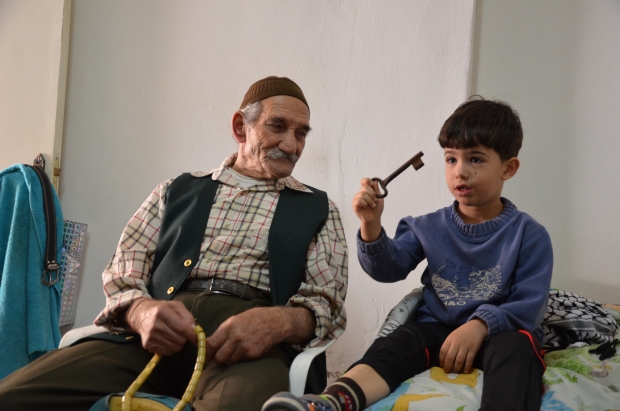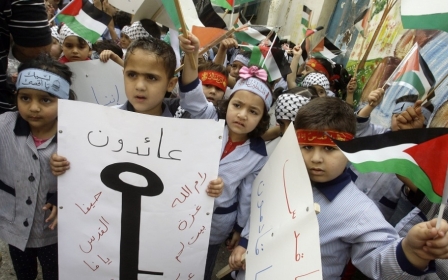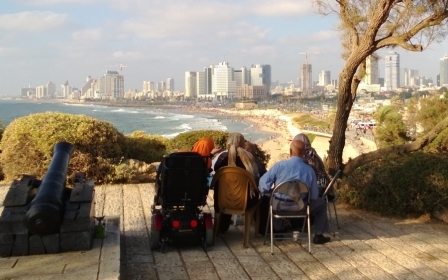For Palestinians, home is still where the heart is
BETHLEHEM, West Bank - In his small three room home in Aida refugee camp, Abu Sabri always has his eye on the time.
His single bed facing the front door has a view of the street. On a ledge beside it rests a large clock and two small alarm clocks. Another clock is nailed to the wall above the bed.
The clocks are set an hour behind the actual time and in the presence of the four clocks, it’s unclear if time is standing still or if Sabri is braced waiting to run out the door back to his village.
Sabri sits in a white plastic chair next to his bed and places his keffiyeh around his head, fixing it firmly with a black cord in a circle.
Wearing a checked shirt and a dark green waist coat with gold buttons, the 87-year-old man begins to tell his story.
New MEE newsletter: Jerusalem Dispatch
Sign up to get the latest insights and analysis on Israel-Palestine, alongside Turkey Unpacked and other MEE newsletters
As Sabari sits, he twists his prayer beads and an old key to his former house between his fingers. He says that it has been 66 years since he left his village, Allar, which was near Jerusalem and once had 500 residents.
His whole village fled overnight when they heard horror stories of people in nearby villages being killed and their homes destroyed.
In October 1948, when camps of Jewish fighters set up on hilltops near Allar were asleep, the Palestinians villagers fled. Not one person remained in the village.
“A week later I found out the village still hadn’t been targeted so I went back and hid in the caves for 13 days and saw the village being destroyed by the Jewish fighters.”
Sabri’s memory of Allar is still as vivid as the day he left and his desire to go back is still burning inside him.
“My desire to go back is stronger than those four clocks, my heart wants to go there,” he says.
“My emotions are so strong, I feel a really strong love for my house.”
Sabri said when he slept at night in his bed in his house in the refugee camp, he dreamt of when he used to milk the cows in Allar and hold fresh grapes in his hands.
“Every night I dream about being there,” he says.
It is evident that the 87-year-old continues to feel displaced here in the Aida refugee camp in Bethlehem, even though he has spent most of his life here.
Sabri’s wife has died and he has a son and five daughters who live in and around the camp, but it currently seems unlikely they will ever be allowed to return permanently to their ancestral home.
The evolution of the Nakba narrative
Thursday marks 66 years since the Nakba, or catastrophe in Arabic, when 750,000 Palestinians lost their homes in the war that led to the establishment of the state of Israel.
According to Arab Israeli member of Knesset Hanin Zoabi, the Nakba wasn’t just an event, “It’s a process”.
“Israel has dominated about five million dunums [500,000 hectares] that belonged to the refugees and all of their assets but still it was not enough.”
Zoabi was the first Arab Israeli woman to be elected to the Israeli parliament on an Arab party’s list and has often used her position to speak out about the injustice that she feels continues to plague the Palestinians.
“What Israel has continued to do after 1948 is to Judaise the area,” says Zoabi. “I cannot study my identity in schools, it’s not just a matter of confiscating land it’s about taking my identity and creating for me a new identity.”
Zaobi explains that Israelis, including Arab Israelis, are being prevented from studying the Nakba.
“It is not just my history, it is the Israelis' history - you have to have to have Nakba,” she says. “We demand the Israeli education system would allow us to study our history."
There has been a lot of misunderstanding about the Nakba as it was not taught in Israel. However, in the late 1980s Israeli historians accessed state archives that had been locked away and began to revisit the controversial period.
The official texts mostly confirmed what Palestinians had always claimed that many were made to leave their homes by force rather than fled.
“We live in an apartheid state, it’s not only undemocratic, it’s never been a democratic state by definition,” says Zoabi.
“In Israel there are 50 laws that discriminate against me, 13 of them regarding land confiscation, they can confiscate land any time.”
When Zoabi talks about the mentality of the Nakba still being perpetuated, she referres to a current scheme, called the Prawer plan,that is being debated by the Israeli government. If approved it would give Israeli authorities the right to forcibly removing Bedouins from their land.
“In Israel there are still 42 unrecognised villages, where else in the world do you hear this term,” says Zoabi.
Just this month, one organisation run by Israeli and Palestinians called Zochrot, Hebrew for remembering, merged the narrative of the Nakba with high-tech app to put Palestine back on the map.
Zochrot have launched an interactive app called “invisible lands” which is a map with images of villages that were destroyed market by virtual pins. While at first glance the barrage of virtual pins is depressing, the photographs and testimonies offer an acknowledgment to the many refugees.
The interactive map in Hebrew, Arabic and English allows people to locate, visit and interact with the over 400 Palestinian villages destroyed since 1948.
Resentments remain for Palestinians and Israelis alike
Professor of history at the Hebrew University in Jerusalem Alex Yakobsen explains that many Israelis believe that responsibility for what happened in 1948 must rest with both the Palestinian and the Israeli sides.
Yakobsen says many Israelis believe there needs to be an acknowledgement that Palestinians did not accept a UN vote to partition British-ruled Palestine into separate Arab and Jewish states.
“The other issue here that is not acknowledged is that there are two refugee problems, there are also the Jews who fled Iraq, Yemen and Morocco who lived in large refugee camps in places like Katamon in Jerusalem.”
Many Israelis are at a point where they could acknowledge the harm caused in the Nakba, but even the Israeli left would stop short of taking sole responsibility, Yakobsen says.
But even bridging this rift will prove extremely difficult. Back in Aida refugee camp Sabri says he remembers his village being cleared out in just four hours.
“Lots of people in the West don’t know our story - they don’t know what we feel. I’ve been back to the village five times and I start crying when I go back," he says.
“I have told my story hundreds of times, but I am still here - but like eating this bread [he gestures at bread on his table] telling my story, gives me energy,” he adds.
While his dreams of returning to his home are growing older, like the rusting key he still possesses, his four-year-old grandson Mohammed, sits playing holding a fresh new silver set of keys to somewhere in the camp, acting as a reminder that time will not stand still.
Middle East Eye delivers independent and unrivalled coverage and analysis of the Middle East, North Africa and beyond. To learn more about republishing this content and the associated fees, please fill out this form. More about MEE can be found here.





